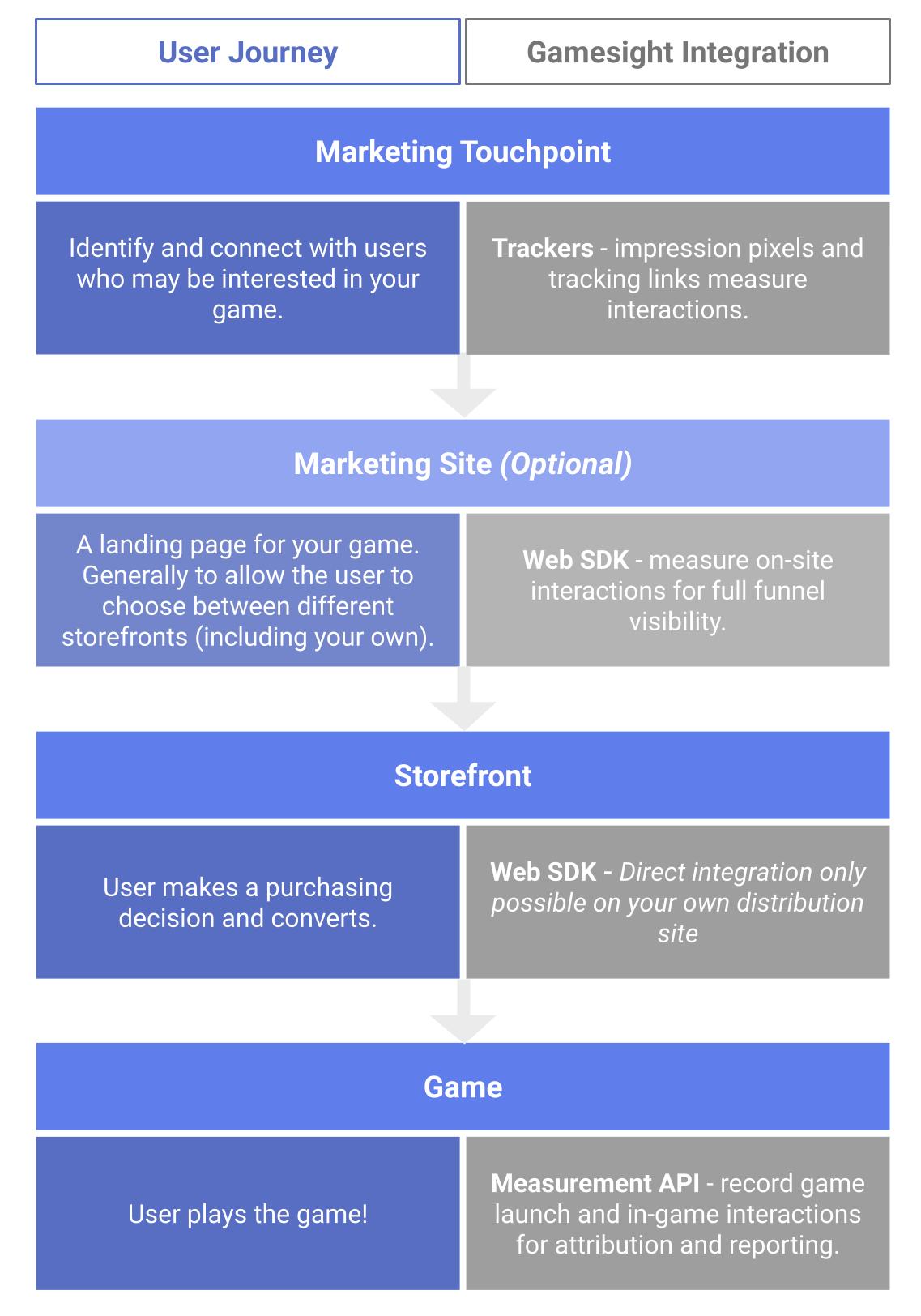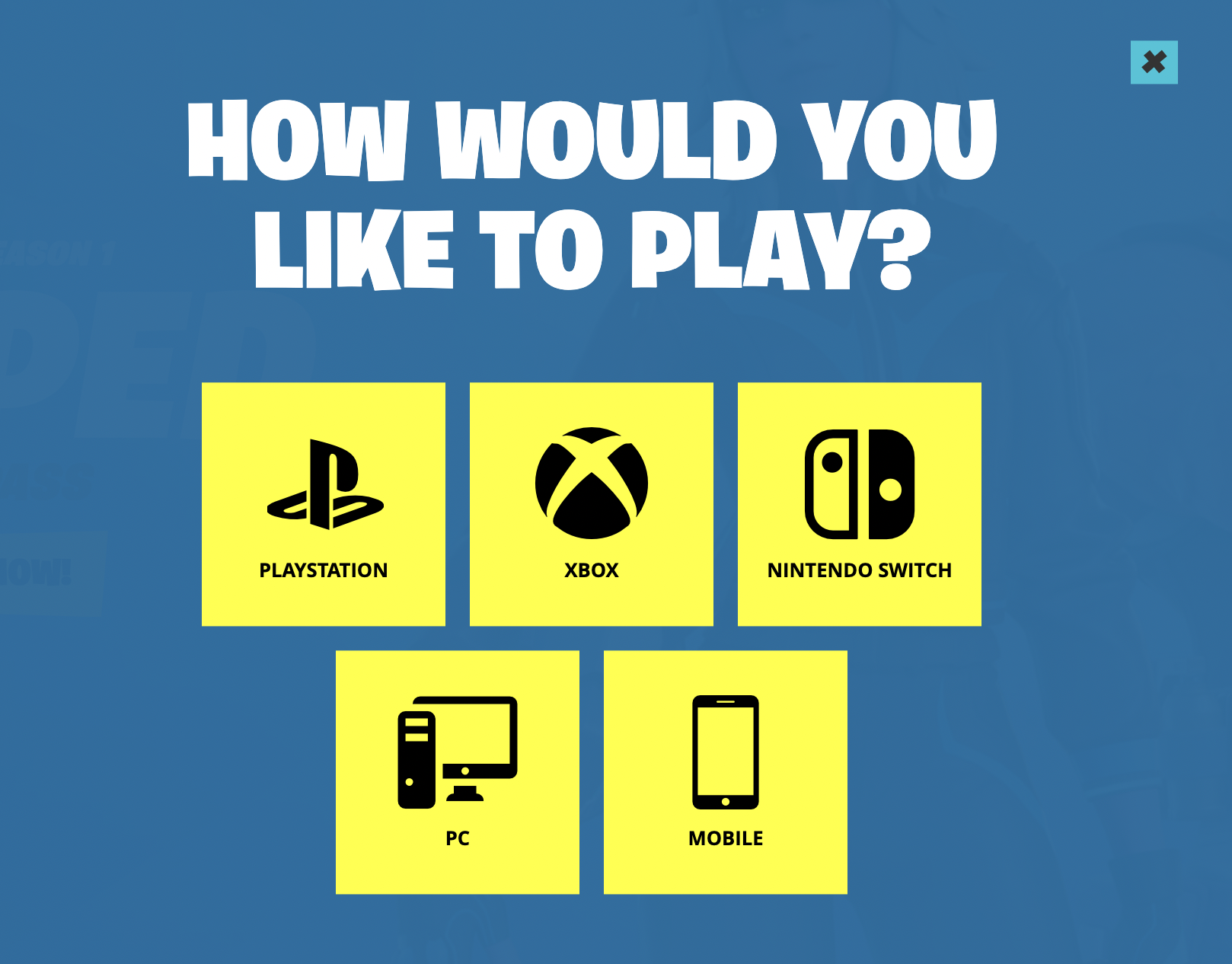Self-Distributed Attribution
This use case guide is for Self-Distributed games. This doc will walk you through utilizing Gamesight for your self-distributed games that are able to be purchased, downloaded, or played directly on your own website or storefront.
When you are self-distributing your games, Gamesight will be able to give you better insight and more visibility into the entire user journey from ad interaction to purchase/download.
Additionally, if your game is distributed across multiple platforms, Gamesight can be used to measure all of those flows as well and would become your unified view of all of your marketing efforts across all platforms.
The diagram below is an overview of the typical user journey in this user case along with notes for the integration points with Gamesight.

Self-Distributed Game Attribution Flow
User Journey
The typical user flow as shown in the above diagram is as follows:
- User sees your Ad (Marketing Touchpoint)
- User interacts with your Ad
- User is directed to your Landing Page (Optional / Self or Cross-Platform Distribution)
- User purchases/downloads your game (either through your Storefront or Steam/Xbox/PlayStation/etc.)
- User installs and launches your game (integrated with the Measurement API)
Here are a few concrete examples of the user journeys that you will be able to measure with Gamesight:
- Users interacting with a Google Ad on their PC, buying the game through your website, then launching the game on the same PC
- Users on your mailing list reading your newsletter, then launching the game and purchasing the DLC in-game
- Users clicking on a Facebook Ad at home on their mobile phone, booting up their PC, and then installing and launching the game
Goal Examples
You can measure many different Goals through Gamesight in a self-distributed flow. Here are some baseline goals that we recommend you implement and track:
- Click-outs to specific storefronts
- Account Creation (optional)
- Purchases
- Downloads
- Installs
- Downstream goals such as reactivations, in-game purchases, retention, etc.
We also offer an Integration Checklist that can be very helpful in planning out the user's journey, integration points, goals that should be tracked, etc. You can find the Integration Checklist here.
Integration Points
For Self-Distributed PC Games there are three required integration points shown below. If you are using a Marketing Site as opposed to driving traffic directly to your storefront, that would become a fourth integration point.
- Marketing Touchpoints
- Marketing Site (Optional)
- Storefront
- In-Game Integration
These integrations enable our core attribution reporting. If you have a user account system for your game where users can create or login to their account on your website, the Web SDK that you will integrate as a part of this guide can be used to connect account systems to your attribution flow which will improve the accuracy of attribution and enable deeper insights into the user journey.
The following sections provide more details about how to implement Gamesight measurement at each of these integration points.
Marketing Touchpoints
Implemented by: Marketer
Touchpointmeasurement determines the shape and content of the reporting that you get out of Gamesight. You should aim to track every part of your marketing efforts using Trackers to ensure that you can see the impact of your marketing efforts and get deep insight into your user journeys.
There are two methods of implementing Touchpoint tracking: Impression Tags and Click Tags. Every time that you make a new Tracker in Gamesight, you will get both impression and click tracking tags. You will need to use these tags when setting up your campaigns to ensure that they are measured through Gamesight. Including the Gamesight tags with your campaign can enable you to report out both click-through and view-through attribution.
For click tracking, this just means that you use your click tracking tag as the destination URL for any ads, marketing emails, or other marketing campaigns that you run. Impression tracking works in largely the same way by placing the impression tag along with your campaign. Note that it may not be possible to use impression tags in all situations due to restrictions on third party tags for some networks.
Network IntegrationsIn addition to our standard tag tracking, Gamesight also has a number of deep Integrations with common advertising platforms which ensure that you get placement-level granularity in all of your reports.
The Tracker system is robust and can be integrated in many different ways to ensure that you get the reporting that you need. For more information about how to manage and use Trackers check out the Tracker Configuration section of our documentation.
Storefront Integration
Implemented by: Web Developer
The most important step to successfully self-distributing your game (on your own website/storefront) with Gamesight is to integrate the Web SDK into your storefront.
Integrating the Web SDK into your storefront would allow you to directly integrate with your internal account system (providing account IDs for deterministic matching), your purchase flow and the download process for full-funnel visibility and insight.
You can find a detailed walk-through that covers integrating the Web SDK for self-distribution here.
In-Game Integration
Implemented by: BI Team / Backend Engineer / Game Developer
In-Game event integration is what unlocks in-game engagement data from your players. This is how you will measure how many users you acquire, how long they are retained, how they engage with your game, in-game purchases, and more.
The base requirement for the in-game integration is a "game launch" event is sent every time a new session starts for the game. From this single event, you can get install, retention, and reactivation reporting for your campaigns. But you don't need to stop there, you can measure and optimize your campaigns towards any action that a user takes in-game. You can read more about other common events to measure in the Additional Goals section below.
Once you have determined which events you want to measure, the integration can begin. The Measurement API requires a few parameters to come with every event - the event type, the user that triggered it, device identifiers for attribution/reporting, and any revenue that is attached to that event. The Measurement API Quick Start guide provides more technical details about how to send events to the Gamesight REST API.
Web Browser GamesIf your game is browser-based, you can use theMeasurement API or the Web SDK to send event data to Gamesight.
Marketing Site (optional)
Implemented by: Web Developer
For games that are distributed through multiple platforms, whether that is both PC & Console or different digital distribution platforms, it is common to have a marketing site for the game. This gives users an opportunity to self-select the distribution platform that they want to get the game through. We also see these types of landing pages used when games either have an account that you can register for prior to installing the game or when the game is self-distributed.
In all of these cases, there are crucial pieces of the user journey that you should measure that occur on your game's website.
Storefront Link
If your marketing site has a call to action to download your game, you can implement Trackers to ensure you capture users going through this flow.

When setting up Trackers for measuring actions/goals on your website, be sure to use the "Internal Website" network. Internal Website trackers are fallback trackers meaning they get deprioritized during the attribution process to prevent any trackers you implement on your internal site from "taking" the credit for your paid campaigns. This means if a user clicks on a Facebook tracker, followed by clicking an Internal Website tracker - Facebook will be attributed and the Internal Website will be counted as an assist.
Once you have created your Trackers, you can use your click and impression tags to start tracking interactions.
Account Creation
If your game has an online account creation flow, measuring account creation will give you both improved visibility into your user journey and improve the accuracy of the rest of your attribution data. You can read more about measuring account creation in the Account Creation (Web) Measurement use case guide.
Cross-Platform Distribution (Optional)
One downside of third-party storefronts is that they are essentially a "black box" when it comes to available insights because you have no available integrations with the storefront, no direct control over the page to measure user activity, the platform itself doesn't measure and report out valuable data, etc.
Gamesight will be able to measure marketing touchpoints, activity on your marketing site if one is instrumented, and then pick back up on the "Install" goal from in-game telemetry (as well as post-install activity such as in-game purchases, retention reporting, etc.).
This can be compared to users that go through a self-distribution flow where you will be able to measure details such as an account creation or registration, purchases, downloads, click-outs to alternative platforms, etc.
Additional Goals
Once you have the core install tracking integration there are many additional Goals that you may want to start tracking. The following use case guides provide more detail about how you can implement these common Goals for your game:
Updated 7 months ago
